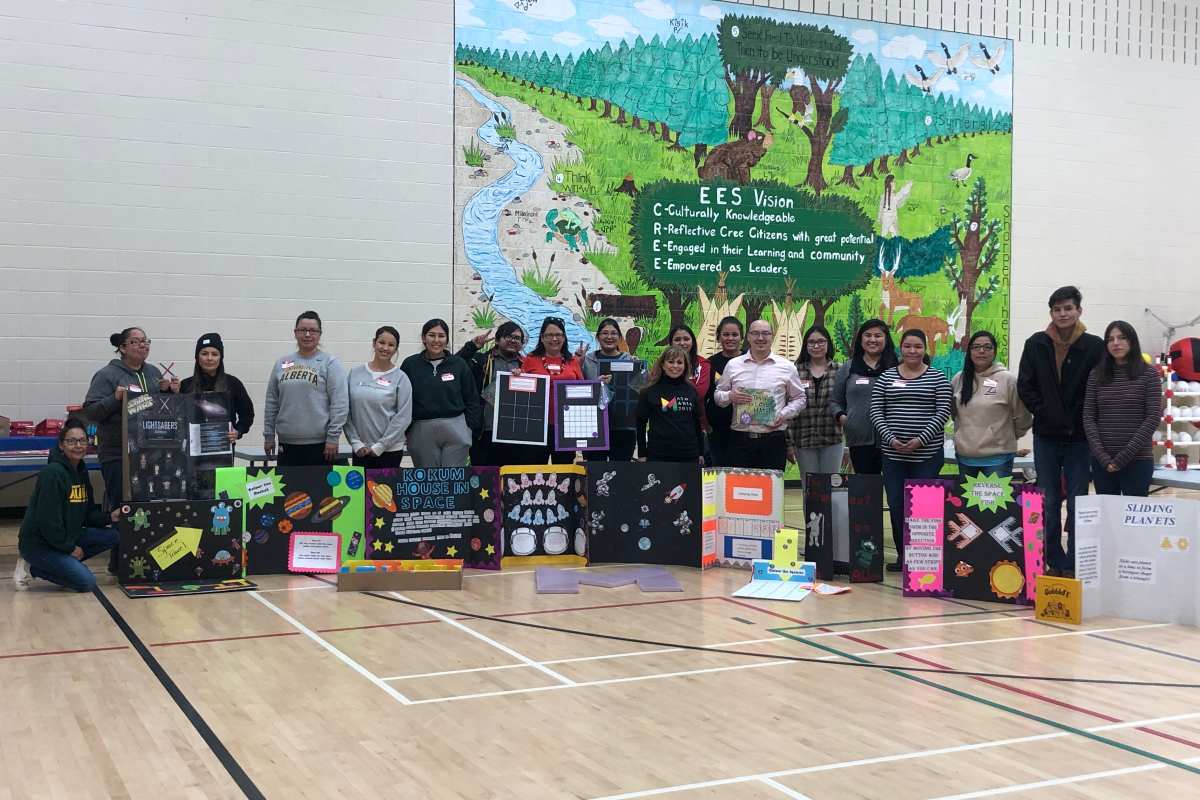
ATEP students prepare to hold a math fair at Ermineskin Elementary School in Maskwacis. Photo supplied by Angela Wolfe, Associate Director, Aboriginal Teacher Education Program (ATEP)
Indigenous students from the Faculty of Education’s Aboriginal Teacher Education Program (ATEP) partnered with faculty from the Department of Mathematical and Statistical Sciences to share the fun side of learning with students at a math fair in Maskwacis in November 2019.
“ATEP is a branch of the Faculty of Education which partners with community-based colleges to train Indigenous teachers,” said Shawn Desaulniers, faculty service officer in the Department of Mathematical and Statistical Sciences, who helped support the event. “It’s designed to help improve the educational success of Indigenous children in rural communities by increasing the number of local teachers.”
The ATEP’s community-based program is an elementary off-campus collaborative cohort program that delivers years three and four of the Elementary education degree program. ATEP is designed to improve the educational success of Indigenous children by increasing the number of Aboriginal teachers and non-Aboriginal teachers with a foundational understanding of Aboriginal histories, worldview and perspectives in communities in Northern and Central Alberta.
The math fair, hosted in partnership with Maskwacis Cultural College, was both an opportunity for both ATEP program volunteers to practice their educational skills and to share a lighter side of mathematics with students.
“These events are great, because the children get an experience with authentic problem-solving,” said Desaulniers. “They’re non-competitive and often require a little creative thinking and persistence. They help to develop confidence and grit amongst the children.”
At the event, students worked with hands-on objects and visual demonstrations to engage in creative problem-solving. Desaulniers shares one of his favourites, where a penny, nickel, dime, and quarter can stand in as students work to solve the problem:
- There are 4 people who want to cross a bridge at night.
- Peggy takes 1 minute to cross the bridge.
- Nick takes 5 minutes to cross the bridge.
- David takes 10 minutes to cross the bridge.
- Queenie takes 25 minutes to cross the bridge.
There is only one torch with them, and the bridge cannot be crossed without the torch. There cannot be more than two people on the bridge at any time, and when two people cross the bridge together, they must move at the slower person’s pace. How fast can you get them across the bridge? (Answer: less than 42!)
Of course, mathematics might not be the first subject one thinks of when considering ways to make learning fun. But the kids not only rose to the challenges—they excelled at them, as Desaulniers explains.
“The ATEP students were a little nervous at first because many students dread math, but they really came together and put on an inspirational event,” said Desaulniers. “It was also a somewhat humbling experience, because the children were fearless and solved many of the problems a little faster, or even in new ways. Some of the kids there were very strong students.”
Desaulniers shares that the strong performance of the students wasn’t the only inspiration to be found at the event.
“The ATEP students who put on the event volunteered to do so—it wasn’t part of any credited course. This is a great example of community members willing to try something different in hopes of inspiring a new generation of scholars. Like all students, they are quite busy balancing all of their academic and life responsibilities, so it was wonderful to see them make time for this and do such a fantastic job.”